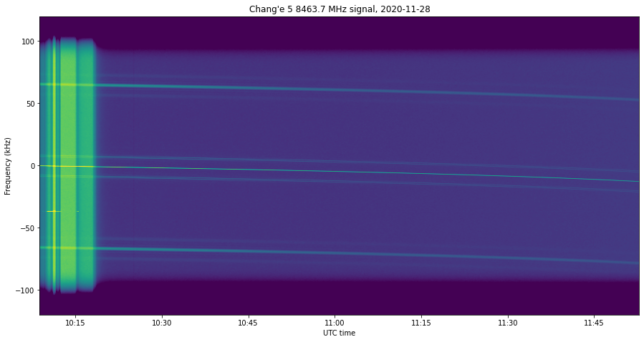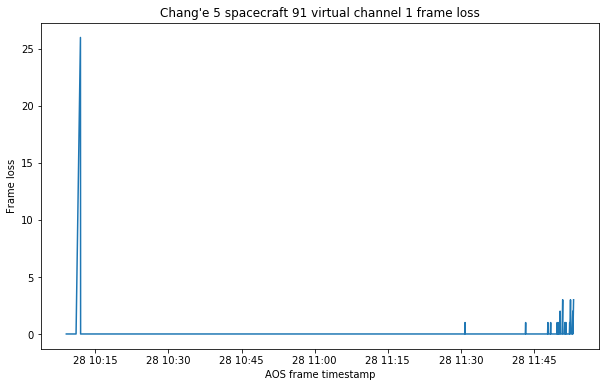In one of my last posts I’ve analysed a recording I made at Allen Telescope Array of the four low rate telemetry signals of Chang’e 5 during the LOI-2 manoeuvre. The previous day, I did an observation several hours before the spacecraft arrived to the Moon and performed the LOI-1 burn. In this observation I only recorded the signal at 8463.7 MHz (which later we discovered that corresponds to the lander), as it was the strongest of all four. In this post I give the analysis of the telemetry in this recording.
The recording corresponding to this observation will be published in Zenodo, but this will be done in a few days, since I’m still transferring files from the telescope. I’ll update the post when it is published.
Update 2020-12-11: the recording is now published in the following datasets:
- Chang’e 5 RF recording at 8463.7 MHz with Allen Telescope Array before LOI-1 (X polarization)
- Chang’e 5 RF recording at 8463.7 MHz with Allen Telescope Array before LOI-1 (Y polarization)
The recording was done in dual polarization and int16_t IQ format at 1.92 Msps. The main carrier is at 37 kHz in the passband. The figure below shows the waterfall of the recording after downconversion and decimation by 8. The strong noise at the beginning is due to a problem with one of the channels of the USRP N321. We clearly see the data sidebands (and even some weak sidelobes of these), as well as the idle telecommand loopback at +/- 8 kHz from the main carrier, which indicates that the signal is in ground-lock. The polarization and signal strength was analysed in this post.

The recording was decoded with the GNU Radio flowgraph ce5.grc, which is basically the same as the decoder that I showed in the analysis of the recording from 2020-11-29. The frames are analysed in this Jupyter notebook, and the file with all the decoded frames can be downloaded here.
As explained in my analysis of the 2020-11-29 recording, the telemetry frames are AOS frames corresponding to spacecraft 91. Two virtual channels are in use: virtual channel 1, which contains real time telemetry, and virtual channel 2, which only contains two packets in all the recording.
The decoding is almost perfect, as shown in the plot of lost frames. We only lose some frames at the beginning, due to the noise problems with the USRP (these frames can actually be recovered if we decode off the X polarization channel only), and some near the end, when the signal gets weaker.

The APIDs present in Virtual Channel 1 are almost the same as in the observation of 2020-11-29, and the contents of most look pretty much the same. The Jupyter notebook contains full plots for each APID. It is interesting to compare each of them side by side between the observations from 2020-11-28 and 2020-11-29.
As usual, each of the frames in Virtual Channel 2 contains a single Space Packet that fills the whole frame. In this case, the two frames were transmitted at 11:38:47 and 11:48:47 UTC, and belong to APIDs 897 and 130. Their contents are shown below. Most of the bytes are 0xaa padding. The purpose of these frames remains elusive to me.

Your work continues to be very impressive. Keep it up!